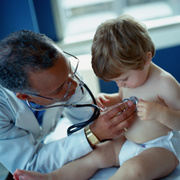Analyzing the Highs and Lows of Children’s Healthcare Spending
- Healthcare spending for children is apparently on the up and up. It has increased more quickly than that of the total employer-sponsored insurance (ESI) population, according to a report from the Health Care Cost Institute (HCCI) which analyzes annual fee-for-service claims for over 10 million ESI-covered children.

Healthcare costs on the rise, says study
Between 2010 and 2013, spending on healthcare for children – individuals who are 18 years old or younger – increased at an average rate of 5.7 percent. Comparably, the total ESI population – all individuals who are below age 65 – increased by 3.9 percent, says HCCI. By 2013, per capita spending on children hit over $2,500, a nearly $400 increase from 3 years prior.
“The rise in children's spending in 2013 occurred despite a drop in the use of prescription drugs and visits to the emergency room, demonstrating that rising health care prices were an important driver behind the spending increase,” confirms HCCI’s press release.
With spending increases across the healthcare spectrum, another notable price hike exists within the realm of inpatient care. 2013 saw somewhat higher admission rates for children, especially for newborns, says HCCI. The price of inpatient admission for a child increased by a total of nearly $750 over the course of one year to reach a cumulative $14,685. Forty percent of per capita healthcare spending related to inpatient admission for both infants and toddlers aged 3 and under, confirms HCCI.
Other healthcare avenues exhibit decreases or slowdowns, says study
The use of prescriptions on behalf of children declined overall up until 2013, HCCI confirms. More generic drugs were being used compared to branded drugs, which confirms spending for children’s prescriptions increased more gradually within 2013 compared to years prior.
There was a specific spike noted across the board regarding the use of generic prescriptions for medications to treat babies, children, pre-teens, and teenagers with asthma and allergies, says HCCI.
Reported increases by age group are as follows:
- 500 percent increase for teenagers, from age 14-18
- 700 percent increase for younger children, from age 4-8
- 800 percent increase for pre-teens, from age 9-13
Despite such increases, HCCI maintains that the use of branded version of such drugs declined to “nearly zero.”
Additional information from HCCI confirms there was a slight decline in teenage labor and delivery admits in 2013, from 5 to 4 admits per 1,000 girls.
Do boys or girls cost more?
Higher per capita spending was noted for boys ($2,716) than girls ($2,426). However, such gender-related spending apparently flipped once children hit their teenage years, according to HCCI. Healthcare spending for male teens reportedly amounted to $2,661 with female teens of the same age costing $2,834.
Younger children between the ages of 4-8 were associated with the lowest spending among the entire ESI population under age 19. HCCI confirms this is likely because young children require fewer medical services overall compared to other children’s age groups. Spending for children aged 4-8 was reported as approximately $1,703 per child in 2013. Comparably, babies age 3 and under reportedly cost over $3,000 more per child in 2013.
Will these noted trends continue into 2016 and beyond?
In light of such data, where should the healthcare industry focus next? How does such data compare to what was reported prior? What trends and algorithms can the healthcare industry predict for the future of healthcare costs for the nation’s youngest patients?
The aforementioned numbers are perhaps primarily significant simply because they affect many children nationwide. Nearly half of all children in the US were covered by ESI in 2013, HCCI confirms.
According to Amanda Frost, HCCI Senior Researcher, "While we know that prices have fueled much of the spending growth, future research should examine whether these expenditures are yielding valuable health outcomes and what the implications are for the future of children's health care.”
Earlier reports from HCCI covering the percent change per capita spending between 2007-2010 confirm health spending grew more expediently for teenagers between ages 14-18. The most common treatments requiring central nervous system drugs for this age range were depression, anxiety, and attention-deficit hyperactivity disorder (ADHD), with an average of 1.2 central nervous system drug prescriptions per insured teen administered in 2010.
“Changes in prices were the driving force of changes in spending on children between 2007 and 2010. Prices grew more than increases in utilization, even after adjusting prices for service mix,” confirms the earlier HCCI 2007-2010 report.
Regarding another comparison, in 2010, earlier HCCI data confirms ESI covered over 40 million children with spending on children rising quicker than inflation with the highest per capita expenditure of any children’s age group connected to infants and toddlers.
Even as healthcare costs may continue to rise as years and decades pass, it is indeed imperative that newborn, child, and teenage patients are able to receive continuous, high quality healthcare.
